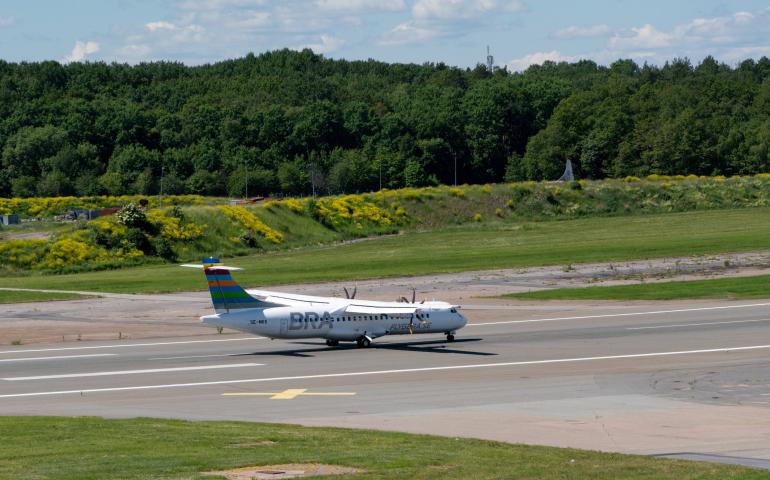
By Eliot Lees, Vice President and Managing Director, Clean Transportation
Suddenly we are all aware of the possibility of electric aviation. Pick up a newspaper and you are bound to see an announcement that some SPAC has just paid billions for an electric aircraft (EA) manufacturer. Start-up companies abound launching radical designs for new electric vertical takeoff and landing (eVTOL) aircraft. A new era of flight will unfold before our eyes and transform the way that we travel in electric aircraft with improved operating economics and environmentally friendly operation—launching in 2-3 years. That is the vision. However, to make the vision a reality in the U.S. is going to take hard work, coordination, and cooperation.
New aircraft technology, both fixed wing and tilt rotor, is relatively close. Several original equipment manufacturers (OEM) have built prototypes and are currently in flight. A number of other OEMs will be following with a wide range of aviation solutions that have adoption potential. While battery technology is still the limiting factor regarding what is possible, the existing generation of lithium-ion batteries is powerful enough to support short haul aviation (500 miles or less) and will be the basis of launching the first generation of EAs.
But proving aircraft technology is only the first step in launching EAs. And how quickly EA move from prototype to market reality will be defined by what we, as industry stakeholders, do to support this effort. Already there is a groundswell of ideas, policy definition, and regulatory revision underway. But to make the vision a reality in the U.S., I believe that there are three key hurdles that need to be tackled: aircraft certification, ground infrastructure, and equipment purchase incentives.
FAA certification
There has been yeoman work undertaken by GAMA, NASA, and other industry trade groups to revise and update FAA Part 135 regulations in order to accommodate fixed wing and VTOL electric aircraft. FAA regulations were originally written more than 50 years ago for a different generation of aircraft and a different technology. The U.S. Air Force, through its Agility Prime Initiative and Race to Certification, has dramatically pushed forward electric aviation. The Air Force recently awarded the first airworthiness approval for a manned EA and intends to start U.S. military piloted trials starting this summer (notably, the Air Force does not need FAA certification to operate EAs). This is a significant step forward in moving electric aircraft toward reality. The Biden administration's stated objectives in sustainable transportation and reductions in GHG emissions also provide impetus to drive this market forward. But much more is needed. There are more than 30 manufacturers currently designing new fixed wing and eVTOL aircraft of various shapes, size, mission capabilities, and technologies. All of these aircraft will need to go through the FAA type certification, and this represents a potential serious bottleneck to the introduction of new clean aviation technology.
The FAA already has strained resources, and the creativity and innovation represented by EAs will only strain the certification process further. To meet the needs of the EA industry, the FAA needs additional staffing, expertise, and most important of all, additional dedicated funding earmarked to supporting the launch of decarbonized flight. This will require additional federal funding to support the FAA's mission. And the FAA will need to bring together the best and the brightest minds to meet this task—be they collaborative resources within other areas of the U.S. government, within industry, or from other regulatory bodies from around the world. In short, it is most urgent that the FAA needs to ramp up its capabilities. Further, since the European Union Aviation Safety Agency (EASA) is currently working on a parallel process to certify the same electric technology aircraft, it would be logical that the FAA share information and research with EASA and make this a collaborative initiative, instead of both moving ahead individually. Clearly, each agency has responsibilities and reports to different state authorities—but this is a worthy initiative to rebuild the bilateral cooperation that was in place for many decades.
Key takeaway: The single most important support that the current administration can provide to advance electric aviation is funding and providing resources to the FAA to make this happen.
Ground charging infrastructure
Unlike petroleum-based aviation, electric aviation will require completely new ground infrastructure to be installed at airports. Electric aviation breaks the traditional economics of fixed based operators and airports fueling aircraft and replaces this with new economics and return on investment. For a substantial period of time, electric aviation, sustainable aviation fuels (SAF), and even hydrogen-based aviation fuels will be operating side-by-side and must be addressed by the market to achieve decarbonized objectives.
If we are to get electric aviation off the ground, the ground charging infrastructure must be in place at airports and non-airport locations in advance of the routes being flown. So building the ground charging infrastructure is a must—yet the payback for this advanced investment is uncertain. The level of activity during the demonstration or proving out phase of EAs will be relatively low. Further, advances in battery technology and fast charging stations may well make the initial investment obsolete shortly after installed. Yet this investment must be made in order to launch this industry. This has been a similar challenge for solar and for development of an electric vehicle (EV) charging network. Federal and state governments extended a combination of grants, loan guarantees, subsidies, and other incentive support to these technologies. The same rational and level of support needed to develop EVs and solar must be applied to electric aviation. And EA charging must be organized as a public-private partnership to make it happen soon.
Key takeaway: This country must encourage the building of a network of ground charging stations at airports and non-airport locations in anticipation of electric aviation as a step in speeding up the move to decarbonized travel.
Operator incentives
A final hurdle to the launch of electric aviation is creating profitable operator business models. Being able to fly an EA is one thing. Being able to operate it profitably in competition to existing petroleum-based aviation is another. OEMs must convince operators that EAs are commercially reliable and financially attractive. While direct operating costs for EA will be significantly less to operators (fuel and maintenance), ownership costs of new technology aircraft, particularly for launch airlines, will be daunting. Manufacturing the first-generation aircraft will be costly and until EAs can be produced at significant scale; the price per copy may well be non-economic.
Obsolescence is also a major risk for launch airlines. Commercial aircraft traditional have had very long lives, with only incremental changes in technology over 20-30 years. Electric aviation is in its infancy and with major leaps in technology and functionality anticipated. This ownership risk in adoption of the technology needs to be addressed by the public sector.
Key takeaway: If the current administration wants to launch decarbonized air travel, they will need to make a commitment to early adopters to reducing the ownership risk of buying first generation electric aircraft—similar to the support provided to other decarbonizing technologies (e.g., solar, wind power, EVs).
Addressing each of these areas must be the combined effort of the public and the private sectors. This must be a collaborative effort joining the creativity of the private sector and the long-term perspective and decarbonized goals of the public sector. Together, we can achieve something truly revolutionary in the field of flight transportation.





Facebook comments